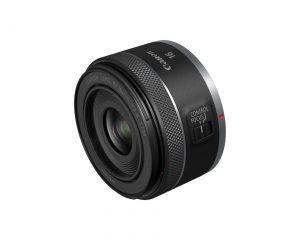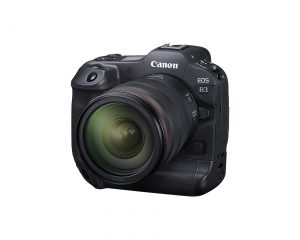Canon Adds Two Lenses to EOS R Full-Frame Mirrorless Lineup; Releases New EOS R3 Camera
Story Highlights
Canon USA has announced the RF16mm F2.8 STM and RF100–400mm F5.6–8 IS USM lenses. In addition, the company has also announced the next leap forward in full-frame mirrorless cameras – the professional-grade Canon EOS R3.
EOS Lenses
 Both lenses invite current EOS R series users and those who are considering a move to Canon’s prominent mirrorless system, such as the EOS R or EOS RP, to expand their content creation abilities with the visual drama of an ultra-wide-angle lens and true telephoto-only zoom lens. As the “lens first” EOS R series continues to expand, these latest lenses open the door to a wide-range of imaging creators, encouraging them to test the powers and possibilities of their art.
Both lenses invite current EOS R series users and those who are considering a move to Canon’s prominent mirrorless system, such as the EOS R or EOS RP, to expand their content creation abilities with the visual drama of an ultra-wide-angle lens and true telephoto-only zoom lens. As the “lens first” EOS R series continues to expand, these latest lenses open the door to a wide-range of imaging creators, encouraging them to test the powers and possibilities of their art.
Whether users are excited to start exploring the creative world of ultra wide-angle photography or someone who is looking to add another lens to expand imaging offerings, the Canon RF16mm F2.8 STM is compact, lightweight and affordable. Long gone are the days of optical corrections or sharpness challenges – the new ultra-wide, 16mm RF lens, for full-frame cameras, comes with a fast and bright f/2.8 maximum lens aperture, as well as smooth and brisk AF (autofocus). This lens is a strong addition to the landscape, architecture or travel photographer — but it also provides the vlogging creator and the EOS Webcam Utility software user the power to integrate environments into their imagery, with its super-wide coverage.
Additional features of Canon’s new ultra wide-angle prime lens with 16mm focal length F2.8 include:
- STM Motor for smooth focusing when recording video
- Compact size and light weight — similar to RF50mm F1.8 STM
- Minimum focus distance of 5.11”
- Maximum magnification of 0.26x
- 43mm filter thread
The Canon RF100–400mm F5.6–8 IS USM provides users with a versatile and popular zoom range that brings subjects closer with ease. It’s an affordable and easily hand-holdable entry into the world of super-telephoto, full-frame photography and video. Offering superb performance and sharpness, the 100–400mm focal length provides a versatile range for all types of telephoto opportunities — be it portraits and documenting events, to sports, birding and wildlife. And, for the first time in a non-L-series lens, the RF100–400mm will accept optional Canon RF 1.4x and 2x tele extenders, offering even more telephoto potential in a lightweight package. Yes, the Canon RF100–400mm is an excellent gateway into the world of wildlife, nature, and sports photography. However, this lens and its super-telephoto abilities can also be leveraged for the video content creator or vlogger when compiling b-roll type footage or for subjects who are at a distance.
Additional features of the Canon RF100-400mm include:
- High image quality — similar to the well-regarded EF 70-300mm f/4-5.6 IS II USM
- 100-400mm telephoto zoom range
- Accepts optional Canon RF 1.4x and 2x extenders
- F5.6 – F8 variable maximum aperture
- Easy hand-held operation — lighter than EF70-300 IS II lens
- Up to 5.5-Stops i optical IS and 6-stops ii correction with coordinated IS
- Nano USM for high-speed and smooth AF
- Smooth and nearly silent AF during video recording
- Superb close-focusing — at 400mm, excellent 0.41x magnification
- 9-blade aperture, for smooth backgrounds/foregrounds
- 67mm filter thread
The Canon RF16mm F2.8 STM and RF100–400mm F5.6–8 IS USM are scheduled to be available in October 2021 for an estimated retail price of $299.00 and $649.00, respectively.
EOS R3
 The new camera leverages the advancements in technology that Canon has developed since the original EOS R launch in 2018 and bridges the gap between the immensely popular EOS R5 and the world-renowned Canon flagship EOS-1D X line. The EOS R3 is the first “3” series camera from Canon since the widely used EOS-3 film camera launched in 1998.
The new camera leverages the advancements in technology that Canon has developed since the original EOS R launch in 2018 and bridges the gap between the immensely popular EOS R5 and the world-renowned Canon flagship EOS-1D X line. The EOS R3 is the first “3” series camera from Canon since the widely used EOS-3 film camera launched in 1998.
The EOS R3 camera’s features greatly emphasize superb AF performance and speed with fast-moving subjects. It was designed to meet the reliability and durability demands of professionals, even when working in some extremely challenging conditions.
“The launch of the EOS R3 sets a new benchmark for the Canon EOS R camera system. Canon listened carefully to the voices of professionals when developing a camera to meet their standards,” says Tatsuro “Tony” Kano, executive vice president and general manager of Canon USA’s Imaging Technologies & Communications Group. “The EOS R3 is a monumental evolution in digital imaging technology. I look forward to seeing the camera in action on the sidelines of sporting events and in the hands of nature and wildlife photographers across the globe.”
The core of the EOS R3 features a Canon designed and manufactured 24.1-megapixel back-illuminated stacked CMOS sensor. The sensor is the first of its kind from Canon, and when combined with the DIGIC X processor, delivers a high-speed readout allowing for continuous blackout-free shooting1 at up to 30 fps in electronic (silent) shutter mode and up to 12 fps in mechanical shutter, with minimum rolling electronic shutter distortion. The combination also increases the high sensitivity, light-capturing efficiency of a native ISO range of 100-102400, expandable up to 204,800 for still images. Like the EOS R5 and R6, the camera features the improved Dual Pixel CMOS AF II with 1,053 AF Points and evolved EOS iTR tracking down to EV -7.5 for subjects such as eye, face, head, animals2, and select cars and motorcycles. In addition, the camera features up to 8 stops3 of in-body image stabilized (IBIS) shake correction.
Leveraging technology and performance feedback from the popular EOS R5 and EOS R6 cameras, the EOS R3 uses Deep-Learning technology to further enhance eye and body detection for even better performance during portrait and action-type shooting. Featuring a new 5.76-million-dot and 120fps blackout-free1 Electronic Viewfinder, the EOS R3 camera will provide photographers with the ability to select the initial area for AF tracking by simply looking directly at the viewfinder location where they want to begin AF. With Eye input AF2 and Servo AF activated, the camera will focus on and track moving subjects at that location in the frame. When Face Detect + Tracking is active, the camera will continue to follow moving subjects around the entire active AF area.
The EOS R3 camera doesn’t just capture spectacular still images, it also packs impressive video specs as well. The camera is capable of shooting 6K 60p RAW and 4K 120p 10-bit uncropped video with Canon Log 3 support, in addition to the possibility for oversampled 4K and RAW movie internal recording. Canon Log 3, which is frequently used in cinema production, helps to reduce the possibility of highlight blowouts. What’s more, the features such as industry standard BT.709, BT.2020 color gamuts, and cinema gamut help to maintain color and tonal consistency. Coordinated 5-axis IBIS helps to correct operator motion or shaking providing dependent video capturing even when using a lens without built-in Optical IS.
Additional features of the EOS R3 Full-Frame Mirrorless Camera include:
- Canon’s next-generation Multi-Function Shoe that is compatible with a variety of accessories including the Speedlite EL-1, and new accessories such as the ST-E10 Speedlite Transmitter, External Mic and Smartphone Link Adapter
- One-piece magnesium alloy design, integrating the body with a vertical grip section
- Weather and dust resistance equivalent to EOS-1D camera models.
- Mobile File Transmitter application for iOS and Android devices allows photographers to transfer their images quickly and easily without the need for wired LAN equipment
- Built-in Wired LAN, 5GHz Wi-Fi, USB and Bluetooth technology
- Dual-card slots, supporting one CF express and one UHS-II SD
The Canon EOS R3 Full-Frame Mirrorless Camera is scheduled to be available in November 2021 for a suggested retail price of $5999.99.
